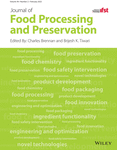Evaluation of kamaboko quality characteristics when it is produced using sorghum distillers grains
Funding information
This work was supported by Meiho University, Taiwan (R.O.C.).
Abstract
Kamaboko is an important fish product that is consumed in high volumes across the globe. This study investigated whether the amount of sorghum distillers grains (SDGs) contained in kamaboko affected its quality. Kamaboko containing SDG had significantly higher cohesiveness and chewiness, but reduced springiness and gumminess. However, the SDG addition ratio had no significant effect on hardness. The pH value (range, pH 4.98–5.87) and cooking loss (range, 2.54–2.71%) were significantly lower than the control group (5.99 and 5.27%, respectively). The kamaboko's emulsification stability and water loss (range, 1.22–1.59%) decreased with increasing SDG; however, the differences were not significant. The fat loss (range, 0.02–0.10%) and water-holding capacity (WHC) (range, 91.56–95.91%) at high SDG addition ratios (100%) were significantly lower than those in the control group (0.07 and 96.12%, respectively).
Practical applications
The results of this study demonstrate the practical application of sorghum distillers grains (SDG), a byproduct of brewing a famous Taiwanese alcoholic drink, kaoliang liquor. Sorghum distillers grains can replace starch in emulsified seafood products, such as kamaboko, to create products with favorable qualities (texture profile analysis, pH value, cooking loss, and emulsification stability). Ultimately, our findings should serve as a reference for exploring the diverse roles of SDG in food processing, provide a basis for adding value to SDG, and help reduce the waste and the environmental problems caused by leftover distillers grains generated during the alcohol brewing process.
CONFLICT OF INTEREST
The authors declare no potential conflict of interest with respect to the research, authorship, and/or publication of this article.




